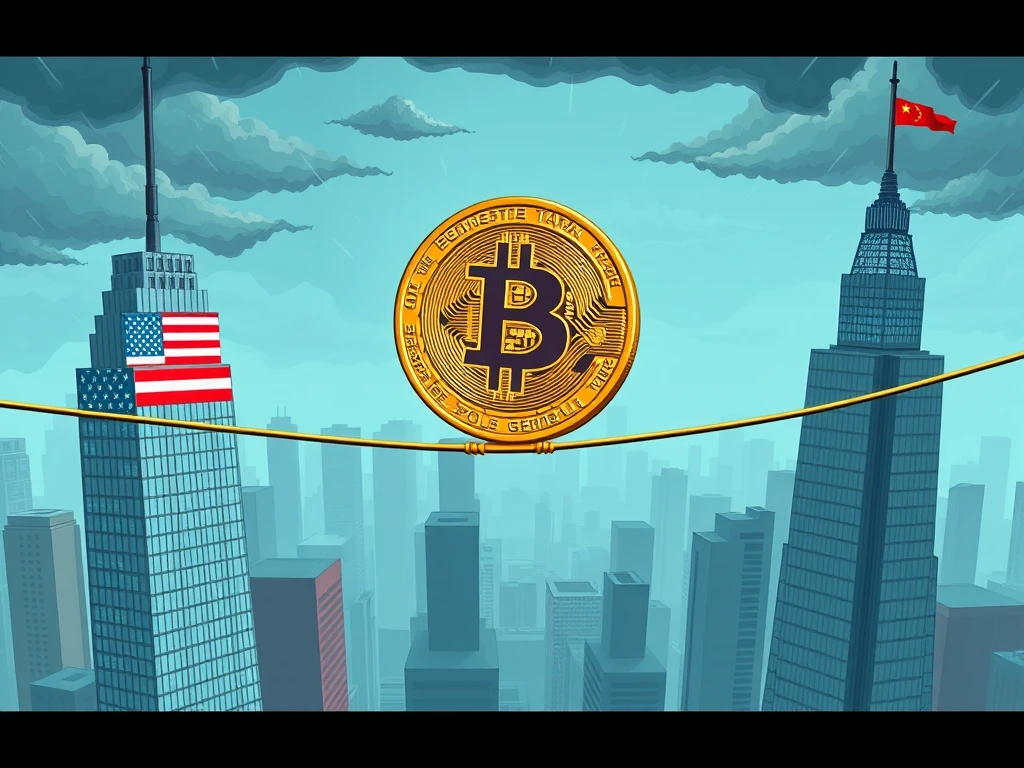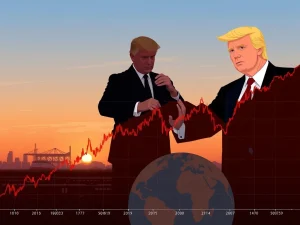Decoding Bitcoin’s Price Mystery: Is the Tariff War a False Flag?

Bitcoin’s journey in recent times has been a rollercoaster, hasn’t it? We’ve seen dips and surges, and the ever-present question lingers: what’s really driving these price swings? While many point fingers at the US-led tariff war, suggesting it’s the primary weight dragging down Bitcoin price, a deeper look reveals a more nuanced story. Is it really just the tariffs, or are we missing crucial pieces of the puzzle? Let’s unpack the factors influencing Bitcoin’s performance beyond the headlines.
Is the Tariff War Impact on Bitcoin Price Overstated?
It’s easy to blame the big, scary headline – in this case, the tariff war. Since President Trump’s announcement of tariffs, the narrative has been that global economic uncertainty is crushing Bitcoin. But consider this: Bitcoin showed signs of struggle before the tariffs even hit. As early as January 21st, before the 10% Chinese import tariffs were announced, Bitcoin was already facing headwinds. The S&P 500, a key indicator of market health, reached an all-time high on February 19th, a month after the trade tensions supposedly began. Meanwhile, Bitcoin had been struggling to consistently break past the $100,000 mark for the three months prior. This timeline suggests that while the tariff war impact is undeniable, it might not be the sole, or even the primary, driver of Bitcoin’s price action.
To illustrate this point, consider the following timeline:
- Pre-Tariff Announcement (Before Jan 21st): Bitcoin showing limited upside, struggling to hold above $100,000 for 3 months.
- Tariff Announcement (Jan 21st): US announces 10% tariffs on Chinese imports.
- S&P 500 Peak (Feb 19th): S&P 500 hits an all-time high, indicating broader market confidence.
- Spot Bitcoin ETF Inflows (Post Jan 21st): $2.75 billion net inflows into spot Bitcoin ETFs in the three weeks after Jan 21st.
- Escalating Trade War (By Feb 18th): US announces tariffs on Canada and Mexico, EU and China retaliate.
Despite the escalating tariff war rhetoric and actions, significant institutional investment continued to flow into spot Bitcoin ETFs. This inflow of $2.75 billion suggests that major players weren’t solely deterred by trade tensions. If the tariff war was the ultimate Bitcoin price killer, wouldn’t we have seen ETF outflows instead?
Spot Bitcoin ETFs and Strategic Bitcoin Reserves: Were Expectations Too High?
Remember the buzz around spot Bitcoin ETFs? Their approval was seen as a game-changer, a gateway for institutional money to flood into Bitcoin. And indeed, we saw substantial inflows. However, some of the initial post-ETF hype might have set unrealistic expectations. Similarly, President Trump’s campaign talk of a “strategic national Bitcoin stockpile” fueled further speculation. When the actual executive order on March 6th didn’t quite match the grandiose vision some investors had, disappointment set in. This unmet expectation, coupled with other macroeconomic factors, contributed to the cooling down of Bitcoin’s upward momentum.
Inflationary Trends: Are They Helping or Hindering Bitcoin?
Bitcoin has often been touted as an inflation hedge. Think back to 2022 when inflation soared. Bitcoin’s gains during that period seemed to validate this narrative. But what happens when inflation is relatively contained? That’s the scenario we’re facing now. Global central banks have been working to manage inflation, and recent data shows some success. In February, the US Personal Consumption Expenditures (PCE) Price Index rose 2.5% year-over-year, and the eurozone Consumer Price Index (CPI) increased by 2.2% in March. These figures, while not zero, are far from the soaring inflation rates of 2022.
When inflation is under control, the investment landscape shifts. Lower interest rates become more likely, which traditionally favors assets like real estate and stocks. These sectors benefit directly from reduced financing costs. Bitcoin, while still attractive to many, might not be the immediate beneficiary in a low-to-moderate inflation environment. Its role as an inflation hedge becomes less critical when inflation itself is less of a threat. The following chart illustrates the relationship between US CPI inflation and US 2-year Treasury yields:
[Chart Placeholder: US CPI inflation vs. US 2-year Treasury yield]
Source: TradingView
Weakening Job Market and Risk Aversion: A Shift in Investor Sentiment
Beyond inflation and tariffs, another crucial factor is the overall macroeconomic environment, particularly the job market. A strong job market often signals economic health and encourages risk-taking. Conversely, a weakening job market can trigger risk aversion. Recent data from the US Labor Department in February showed job openings near a four-year low. This, coupled with falling yields on the US 2-year Treasury (down to a six-month low at 3.88%), points towards increased risk aversion among investors. When investors favor the safety of government bonds with modest returns, it signals a broader pullback from riskier assets like Bitcoin.
This shift towards risk aversion is a significant headwind for Bitcoin. In times of economic uncertainty or perceived weakness, investors tend to flock to safer havens. Government bonds, backed by national economies, are seen as a less volatile option compared to the crypto market. This preference for safety can dampen demand for Bitcoin and other cryptocurrencies.
The Real Drivers of Bitcoin’s Price: Beyond the Tariff War
So, while the tariff war certainly adds to the complex global economic picture, it’s not the sole determinant of Bitcoin price. The current price softness appears to be a confluence of factors, including:
- Unrealistic Expectations: Overly optimistic projections regarding US Treasury Bitcoin acquisitions and the immediate impact of spot ETFs.
- Controlled Inflation: Lower inflation reducing Bitcoin’s appeal as a primary inflation hedge and shifting investor focus to traditional assets.
- Increased Risk Aversion: A weakening job market and broader economic uncertainty leading investors to seek safer investments like government bonds.
In conclusion, understanding market analysis for Bitcoin requires looking beyond the surface narratives. While the tariff war is a convenient scapegoat, a deeper dive reveals a more intricate web of economic forces at play. By considering factors like inflation, job market data, and investor risk appetite, we gain a more accurate and comprehensive understanding of the dynamics influencing Bitcoin’s price movements. The crypto market, as always, demands a nuanced perspective, and focusing solely on one headline, like the tariff war, risks missing the bigger picture.
Disclaimer: This article is for general information purposes only and does not constitute investment advice. Always conduct thorough research and consult with a financial advisor before making any investment decisions.








